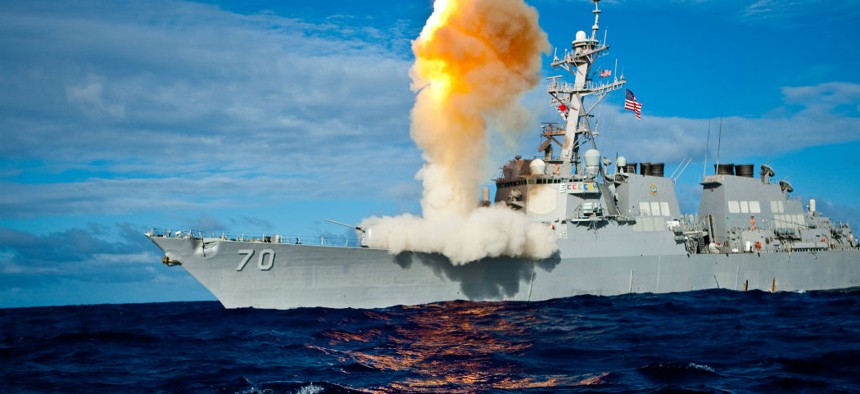Navy advances Aegis radar, RF in destroyer overhaul
The service is modernizing Aegis technology with multi-mission signal processors, kill assessment systems, and radio frequency upgrades.
The Navy is modernizing its destroyers and cruisers with Aegis technology equipped with new multi-mission signal processors, kill assessment systems, and radio frequency upgrades, service officials said.
The upgrades are part of an intense effort to arm the fleet of destroyers and cruisers with modernized Aegis radar technologies to help the ships better attack adversaries and defend themselves from enemy missiles.
Aegis radar, a technology now on destroyers and cruisers, provides terminal phase ballistic missile defense and an ability to knock out or intercept attacking enemy cruise missiles.
Raytheon has been awarded a $20 million deal extension to perform these Aegis upgrades.
The Navy is both modernizing current Aegis technology on board existing ships and also building upgrades into ships now under construction. These new upgrades are designed to build upon the most current iteration of Aegis technology, called Baseline 9.
The Aegis modernization program hopes to achieve combat system upgrades that will enhance the anti-air warfare and ballistic missile defense capabilities of Aegis-equipped DDG 51 Arleigh Burke-class destroyers and CG 47 Ticonderoga-class cruisers.
“Over the years, we've added capabilities (helicopters, increased VLS – vertical launch systems -lethality, improved Aegis weapon system performance, SeaRAM) without the need for a new ship program and associated delays,” Rear Adm. Ronald Boxall, director of surface warfare, said in a statement.
The next step in this continuum of modernization is equipping the next-generation DDG Flight III destroyers with the SPY-6 Air and Missile Defense Radar, Boxall added.
The Navy’s new SPY-6 is 35-times more powerful than existing ship-based radar.
Compared to the legacy SPY-1 radar, Air and Missile Defense Radar will be able to see an airborne object half as big and twice as far and testing is proceeding apace at Pacific Missile Range Facility, where we have radiated at full power and cycle, Boxall added.
Boxall added that all new construction DDG Flight IIA ships, beginning with DDG-113, will be delivered with Aegis Baseline 9C.
This includes "identification Friend or Foe Mode 5, Close-In Weapons System Block 1B, Surface Electronic Warfare Improvement Program Block II, and the SQQ-89A (V) 15 Integrated Undersea Warfare Combat System Suite. Delivery of these capabilities will extend into the mid-term (2020-2030) and beyond," Boxall said.
NIFC-CA & New Navy Destroyers
Baseline 9 Aegis radar also includes a new fire-control system, called Naval Integrated Fire Control – Counter Air, or NIFC-CA. It has already been deployed on a Navy cruiser serving as part of the Theodore Roosevelt Carrier Strike Group in the Arabian Gulf, Navy officials said.
The technology enables ship-based radar to connect with an airborne sensor platform to detect approaching enemy anti-ship cruise missiles from beyond the horizon and, if needed, launch an SM-6 missile to intercept and destroy the incoming threat, Navy officials said.
“NIFC-CA presents the ability to extend the range of your missile and extend the reach of your sensors by netting different sensors of different platforms -- both sea-based and air-based together into one fire control system,” a senior Navy official said.
So far, NIFC-CA has been integrated and successful in testing with both E2-D Hawkeye surveillance aircraft and F-35 Joint Strike Fighters.
The Navy’s current plan is to build 11 Flight IIA destroyers and then shift toward building new, Flight III Arleigh Burke-class destroyers with the new SPY-6 massively more powerful radar system. Flight III Arleigh Burke destroyers are slated to be operational by 2023, Navy officials said.
In addition, some future Arleigh Burke-class destroyers such as DDG 116 and follow-on ships will receive new electronic warfare technologies and a data multiplexing system which controls a ship’s engines and air compressors, Navy developers have said.
The NIFC-CA technology can, in concept, be used for both defensive and offensive operations, Navy officials said.
Having this capability could affect the Pentagon discussion about how potential adversaries could use long-range weapons to threaten the U.S. military and prevent its ships from operating in certain areas -- such as closer to the coastline. NIFC-CA could enable surface ships, for example, to operate more successfully closer to the shore of potential enemy coastlines without being deterred by the threat of long-range missiles.
More recently, the Navy is again shifting its focus toward near-peer adversaries and seeking to arm its fleet of destroyers, cruisers and Littoral Combat Ships with upgraded or new weapons designed to increase its offensive fire power.





